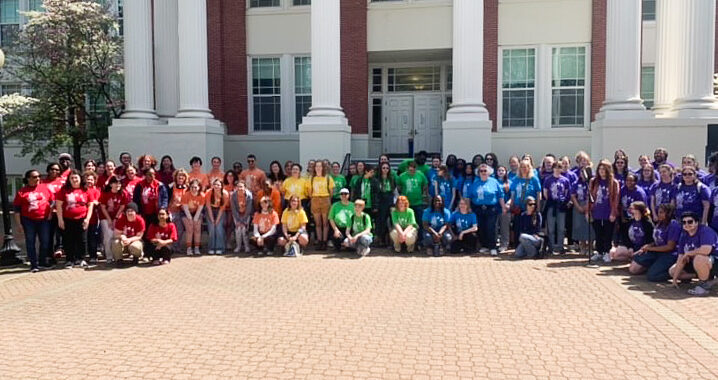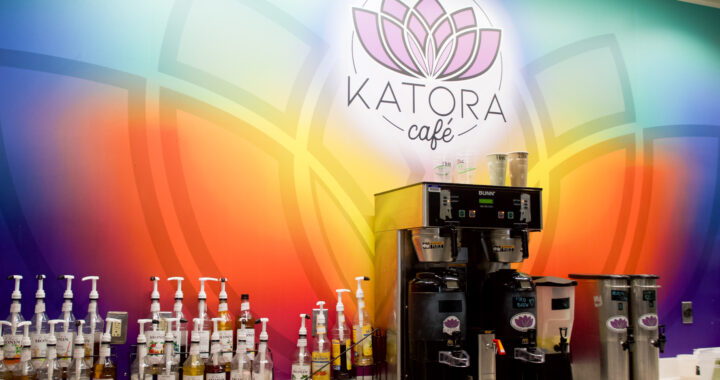Sociology class hosts forum on students’ safety concerns
4 min read
A flyer in Arrington Hall advertises the special topics sociology class' three police forums. | Josephine Johnson, The Blue & Gray Press
By JACK BREWSTER
Staff Writer
The special topics sociology class, Invention of Police: Social Control, held its first virtual public forum on Thursday, April 1. This forum was the first in a series of public forums regarding campus safety. Thursday’s session was focused on analyzing students’ responses to the Community Advisory Panel (CAP) survey to show how students feel about safety on and around campus. The presenters found that intersectionality, or the overlapping of oppression and privilege based on one’s identity, helped to explain how safe or unsafe students felt.
Brianna “Breezy” Reaves, a junior sociology major and one of the student speakers, explained the class’s goal for the student forum.
“The end goal of our webinar is to make students aware of the data that comes from student experiences at UMW as a means to begin unpacking their definition of safety,” she said.
CAP conducted this survey in the fall 2020 semester from September 28 through October 7. They sent the survey to 4,294 students through email and received 1,457 responses back.
The presentation opened with a question for the audience: “What comes to mind when you encounter the word safety?” Several respondents said it meant being free from fear, being able to walk home alone at night, the ability to live without the threat of violence and not being discriminated against.
When going over the data, the class presented that 89 percent of all male students and 79 percent of all female students agree that UMW is safe. When this was expanded to all students at UMW, it was increased to 93 percent. But when they separated the responses by sexuality identity/orientation, race and gender, they found discrepancies in students’ feelings of safety, which they explained through intersectionality.
They looked at sexuality identity/orientation first and found that 40 percent of queer students and 56 percent of pansexual students do not feel safe at night on campus, while 52 percent of lesbian students do not feel safe on campus in general. All students who took this survey self-identified their sexual orientation.
“When looking at the larger numbers, it seems like safety on campus is good, but when the categories are broken down, the results are very different,” said Reaves.
Similar discrepancies were found by examining racial groups. In regards to race, 40 percent of Black students do not feel safe at night on campus, 56 percent of mixed-race students do not feel safe in the neighborhood close to campus and 24 percent of mixed-race students do not feel safe in campus parking areas.
Finally, the presenters examined the data by gender. They found that 55 percent of female students do not feel safe alone in neighborhoods at night, 26 percent of female students do not feel safe alone on campus at night and 5 percent of male students do not feel safe alone on campus at night.
The surveys also asked for comments regarding UMW PD. In total, 125 student comments expressed appreciation for UMW PD, while 117 comments included statements with negative themes. When the qualitative resopnses were reviewed by those who originally conducted the survey, the negative responses were separated into these categories: lack of faith [in the department], discrimination, lack of professionalism, defunding and criticism.
The presenters then asked what UMWcan do to make campus safer for students as a whole. An anonymous attendee wrote in the chat, “We need more funding for other programs that aren’t just the police department. We also need more accountability and transparency from them, it seems like they are reluctant to agree to a lot of what the students want. The JFMC, Talley Center, Title IX.”
Another anonymous attendee wrote in the chat, “Implementing more preventative measures such as awareness of how other people feel about safety. Data like this should be advertised more across campus to bring awareness to this subject.”
Other commenters said that having more forums that bring awareness to student safety would help, and another comment suggested that UMW PD should host public forums, such as this one, to help students express their concerns. UMW PD Chief Michael Hall responded to this by saying “100% agree to talk and meet” in the chat.
In an interview, Hall added, “Always willing to [meet], the well-being of the community is always a priority of the UMW PD. We need to change the perception of being safe so that more people feel safe.”
Hall believes that UMW PD has already addressed the changes that students are pushing for.
“I encourage people to read the reports and ask questions about their requests. Most of the time the things that people request have already been changed or are already in the works. When talking about funding, the UMW PD takes up less than 1 percent of the entire budget. Download the Guardian app, you can text directly to the police department. Less than 10 percent of students use it. Access control and cameras have been improved on. The students don’t realize that a lot of the things they push for are already happening.”
Reaves hopes that more students will attend the forums and get more involved. “I encourage all students to get involved in these forums and to interact with the data presented,” she said. “The presentations are well constructed, and the presenters are very committed to interacting with participants in a way that further personalizes the material! We also have a class website that provides more information about everything.” The website can be found at https://socg371.umwblogs.org/.
The class is hosting the next forum on Monday, April 5 at 7 p.m. about the faculty and staff data, and their third and final forum will be held on Wednesday, April 14 at 7 p.m. about the alumni data. The presenters emphasized that all are welcome to attend.











